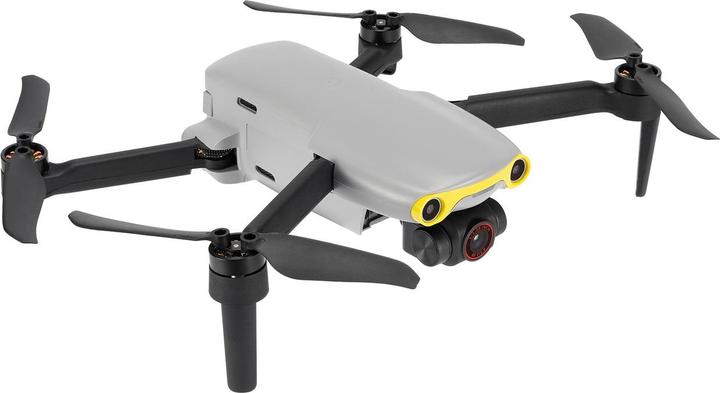

Comparison test: DJI Mini 3 Pro vs. Autel Evo Nano+
The DJI Mini 3 Pro has obstacle detection and an advanced camera. The Autel Evo Nano+ mini drone has been offering this for a while. This test compares the currently best drones under 250 grams.
The new DJI Mini 3 Pro has recently become available. How does it compare to other mini drones? It doesn't take a test to find out that it's better than the Mini 2. The "Pro" in the name says that it's not just the successor, but a drone that's positioned above the previous Mini. And the price also expresses this unequivocally.
Another, lesser-known drone is more in the Mini 3 Pro's range: the Autel Evo Nano+. It has similar features and is similarly priced - in Switzerland it is currently a bit cheaper, in Germany more expensive than the DJI Mini 3 Pro. The Autel Evo Nano+ came out as early as 2021, but was poorly available for a long time. Now I have one and can compare it with the new DJI tiny one.
Similarities and differences
Both drones weigh 249 grams. Also, unlike the DJI Mini 2, both have automatic obstacle detection and object detection for automatic tracking or circling. The camera's sensor is about the same size on both, and significantly larger than on the DJI Mini 2. DJI lists the size as 1/1.3 inches, while Autel lists it as 1/1.28 inches.
Externally, the Evo Nano+ is more reminiscent of the Mini 2 than the Mini 3 Pro. The legs are attached to the propeller arms like most drones. The Mini 3 Pro, on the other hand, basically lands on its belly, with tiny feet attached to its body.
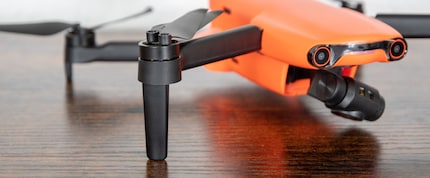
The first thing you notice in the pictures is the bright orange color of the Autel drone. However, it is also available in gray, white and red.
There are two different controllers to choose from for the DJI drone: With a built-in screen and the classic, cheaper version where the smartphone is clamped in a holder. I use the version with screen and would never want to control a drone with anything else. Just turn on both devices and everything is ready to go. No fumbling with cables, no problems due to low smartphone battery.
With Autel, there is only one controller for the smartphone. But even when I compare the two smartphone controllers, DJI clearly wins for me. Due to its design, the DJI controller requires much less space in the transport bag. Both bags are about the same size. While it is very tight in Autel's bag, DJI still has comfortable space for other accessories, such as a small box of ND filters. The connection cable and the unscrewable levers can also be stored in the remote control itself - with Autel, I have to put them in a pocket.
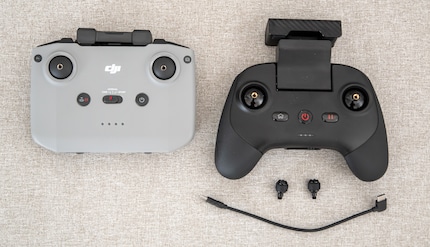
A small plus point for Autel: The remote control feels grippier and more comfortable. However, since it is not a racing drone, I do not find this important.
The Autel controller does not have its own switch for the speed modes like DJI. But there is a freely configurable Fn button on which I can put this function. With a double click it offers another freely selectable function.
Loading
Both drones can be charged with any USB power adapter. There is an optional multi-charger for both that holds three batteries. The mechanism is virtually identical. The charger detects which battery still has the most power and charges that one first. Then the next fullest one. The charging capacity is indicated by four flashing or permanently lit dots for both manufacturers.
The Autel charger does not have a housing for the batteries - they are attached to a rod, where they do not hold very well. This does not save space compared to DJI, where the batteries can be stored in the charger for transport.
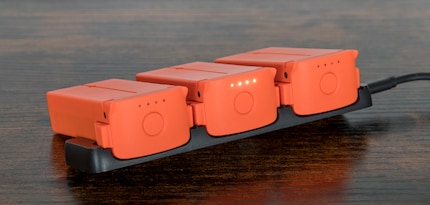
Flight characteristics
Obstacle detection works flawlessly on both drones in the test. It can be activated or deactivated for each flight mode, except for the fastest mode, which is called Sport for DJI and Ludicrous for Autel: There, the detection is deactivated. Not because this mode is particularly safe, quite the opposite, but because the drone flies too fast for obstacle detection.
With the Mini 3 Pro, you can set whether the drone should brake or avoid an obstacle. I did not find this option on the Autel Evo Nano+ - it simply brakes.
Both drones use their sensors to detect obstacles only in front, behind and below them. Upwards or sideways, the obstacle detection does not work. Therefore, on the DJI Mini 3 Pro, you can disallow flying sideways in the settings. Either way, obstacle detection is not a worry-free guarantee - paying attention and flying on sight remains mandatory.
Both drones can be flown smoothly even in windy conditions despite their light weight. They do wobble, but the footage is steady - the gimbal compensates for everything.
I didn't fly in extreme conditions, so I can't say at what point the drones become uncontrollable. However, according to this test video, the DJI drone seems unfazed even by stormy winds. The Autel drone apparently also copes with strong winds after a firmware update.
My impression: the flight behavior of the Autel Evo Nano+ is good, but the DJI Mini 3 Pro beats everything. It flies as if it were on rails. The safety distance provided by the obstacle detection is smaller than the Nano+, so I can fly closer over a cornfield, for example - and I have full confidence that the drone won't crash at this short distance.
The Mini 3 Pro also seems safe to me indoors, i.e. without GPS. The Nano+ flew itself into the wall when I tried to measure the volume, steering backwards did nothing. Both drones are about equally loud, but the DJI Mini 3 Pro's motor noise is lower and therefore more pleasant.
Shots
In general, both cameras deliver very good images for mini drones, both are clearly better than the DJI Mini 2.
The Autel Evo Nano+ has no internal memory, the DJI Mini 3 Pro only 1.25 GB - so at least for videos you will definitely need a microSD card. With the DJI Mini 3, I can get the card in easily, but it's difficult to get it out again. It works better with the Autel.
I started the camera test of the DJI Mini 3 Pro with a blurry shot. It was new to me that I could take blurry shots at all with a small drone. Because of the large sensor and the large aperture of f/1.7, the focus area is smaller than usual for hobby drones. A field for autofocus can be seen on the screen: The camera focuses on this area. However, this does not happen automatically or only very slowly. Otherwise, the camera would have focused here at some point.
To be on the safe side, that the shots will be sharp, I switched to manual focus with a long distance. For normal landscape shots, nothing else is needed. The Autel Evo Nano+ seems to work exclusively that way, I couldn't set a focus there.
JPEG photos
The photo resolution of the two drones is very similar: 4032 × 3024 pixels for DJI and 4096 × 3072 pixels for Autel. Both can shoot JPEG and DNG - even simultaneously. DNG is a standardized raw format, so it offers more post-processing options than JPEG.
Here first two JPEGs in comparison:
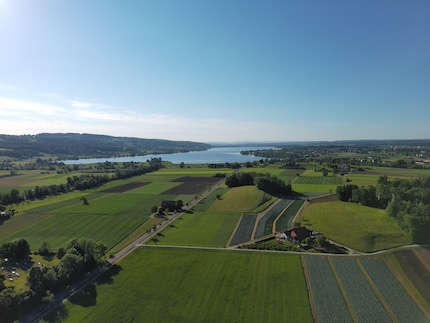
The fact that the fields are darker on Autel is not so much because of the camera, but because the lighting situation is not the same due to the angle. Both cameras make crisp JPEG images with bright colors. In terms of magnification, both are about on par.
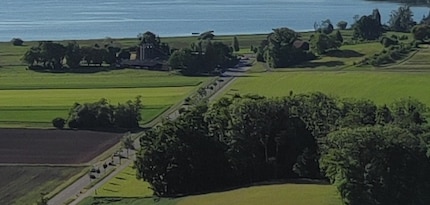
RAW photos
When processing the raw data, I fare similarly with both drones. I can bring out a bit more detail compared to the JPEGs. Color correction is more difficult than with a "real" camera. If I switch the white balance warmer, the landscape looks more natural, but the sky bleaches out. The brown field in this image has a strong tendency to purple. The latitude is small compared to the RAW files of a large camera.
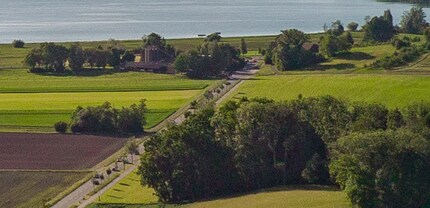
High-resolution photos
Both cameras can produce images with four times the resolution, which means 48 megapixels for DJI and 50 for Autel. But what looks like the same thing at first glance is very different on the two drones.
With DJI, the difference in dynamics is clear. At reduced resolution, four pixels are combined into one to simulate large, light-sensitive pixels. Therefore, the 12-megapixel images become much better than the 48-megapixel images when there are strong differences in brightness. With Autel, this difference is barely visible. The Autel drone handles strong contrasts very well regardless of resolution.
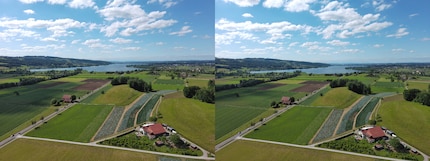
The catch, however, is that the high-resolution image on Autel isn't one at all. In fact, the 50 megapixels are of no use. When you enlarge the images, you can't see any more detail than with 12 megapixels. It's different with DJI.
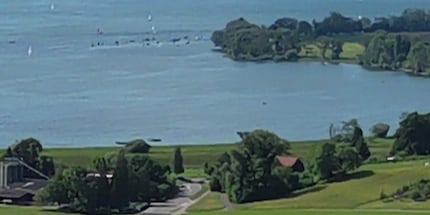
In addition, DJI also delivers the high-resolution format in raw format, Autel only as JPEG. The lack of dynamics can thus be compensated for to some extent.
In short: With Autel, it is not clear what the high-resolution photos are supposed to be good for. They look practically the same as the normal ones. With DJI, on the other hand, it's clear: you sacrifice dynamic range in favor of resolution.
Portrait
The DJI Mini 3 Pro lets you take full-resolution portrait shots - the gimbal rotates 90 degrees. This can be useful for social media videos, for example, if you set the drone to track you.
Videos
It's best to check it out for yourself right now. Here's a short clip of a shot of the Autel Evo Nano+ at 4K and 30 frames per second.
And here's the whole thing with the DJI Mini 3 Pro.
Both videos are very good. Autel prepares the contours a bit crisper and the colors even brighter - I like it here super. But I don't know if this processing is better in every situation. Both cameras offer manual settings in case of doubt and even shooting with a log profile. This offers, similar to the DNG format for photos, more leeway in post-processing.
When I shot with the Autel drone, the camera pans much faster, which is why there are noticeable jerks. One way to smooth out such jerks is to use ND filters. Another is to increase the frame rate.
And here comes an important point where the DJI Mini 3 Pro is superior to the Autel Evo Nano+. Namely, only DJI offers 4K at 60 fps. With Autel, you have to resort to Full HD. Even worse, the Full HD footage at 60 fps shows a severely narrowed frame and is less sharp than Full HD could be.
Conclusion
The DJI Mini 3 Pro wins the head-to-head comparison against the Autel Evo Nano+. This is not because the Autel drone is bad, but because the Mini 3 Pro is so good. The excellent flight characteristics, sophisticated controls, and advanced shooting capabilities make it a near-perfect drone. For hobbyists, the question is why they need a larger drone at all.
The only weaknesses of the DJI Mini 3 Pro are the slow autofocus, which the competitor doesn't have at all - and the fiddly slot for the SD card.
The Autel Evo Nano+ is also very good. Its landscape shots look a bit more vivid than DJI's, and it's currently a bit cheaper - but only in Switzerland. It also comes in different colors. Other than that, however, it doesn't beat its competitor anywhere. In a direct comparison, it lacks a usable video function in 50 or 60 fps and a remote control with a screen.
My interest in IT and writing landed me in tech journalism early on (2000). I want to know how we can use technology without being used. Outside of the office, I’m a keen musician who makes up for lacking talent with excessive enthusiasm.
